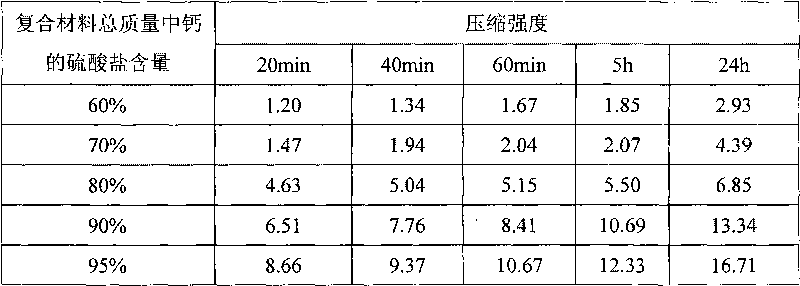Injection moldable bone repair composite material and preparation method thereof
A composite material and injection molding technology, which is applied in the field of medical composite materials, can solve the problems of uncontrollable degradation rate, uncontrollable degradation rate, and inability to provide mechanical strength of calcium sulfate bone substitutes, so as to achieve adjustable degradation rate and reduce medical expenses , fewer complications
- Summary
- Abstract
- Description
- Claims
- Application Information
AI Technical Summary
Problems solved by technology
Method used
Image
Examples
Embodiment 1
[0022] Take 105g, 11g, 4g, and 3g of ε-aminocaproic acid, glycine, phenylalanine, and proline respectively, add them to a 250ml three-necked bottle, add 50ml of distilled water, protect with nitrogen, stir and heat up to 180°C to 200°C °C for dehydration. After the dehydration is completed, continue to heat up to 210°C to melt, then heat up to 220°C, carry out prepolymerization for one hour, add 89g of calcium sulfate dihydrate, continue to react at 220°C to 250°C for 2 to 3 hours, and then stop to obtain calcium sulfate 40% matrix composite material.
[0023] Crush the above matrix composite material to 120 mesh to 200 mesh, take 50g of it, add 54g of α-calcium sulfate hemihydrate, compound and prepare composite material powder. Use 60ml of sodium chloride injection to reconcile the composite material powder into a paste to obtain an injectable rapid prototyping calcium sulfate / quaternary amino acid copolymer composite material with a calcium sulfate content of 70%, and the ...
Embodiment 2
[0025] Take 105g, 11g, 4g, and 3g of ε-aminocaproic acid, glycine, phenylalanine, and proline respectively, add them to a 250ml three-necked bottle, add 50ml of distilled water, protect with nitrogen, stir and heat up to 180°C to 200°C °C for dehydration. After the dehydration is completed, continue to heat up to 210°C to melt, then heat up to 220°C, carry out prepolymerization for one hour, add 89g of calcium sulfate dihydrate, continue to react at 220°C to 250°C for 2 to 3 hours, and then stop to obtain calcium sulfate 40% matrix composite material.
[0026] Crush the above matrix composite material to 120 mesh to 200 mesh, take 50g of it, add 107g of α-calcium sulfate hemihydrate, compound and prepare composite material powder. Use 94ml of sodium chloride injection to reconcile the composite material powder into a paste to obtain an injectable rapid prototyping calcium sulfate / quaternary amino acid copolymer composite material with a calcium sulfate content of 80%, and the...
Embodiment 3
[0028] Take 105g, 11g, 4g, and 3g of ε-aminocaproic acid, glycine, phenylalanine, and proline respectively, add them to a 250ml three-necked bottle, add 50ml of distilled water, protect with nitrogen, stir and heat up to 180°C to 200°C °C for dehydration. After the dehydration is completed, continue to heat up to 210°C to melt, then heat up to 220°C, carry out prepolymerization for one hour, add 89g of calcium sulfate dihydrate, continue to react at 220°C to 250°C for 2 to 3 hours, and then stop to obtain calcium sulfate 40% matrix composite material.
[0029] Crush the above matrix composite material to 120 mesh to 200 mesh, take 50g of it, and take another 267g of α-calcium sulfate hemihydrate, compound and prepare composite material powder. Use 190ml of glucose injection to reconcile the composite material powder into a paste to obtain an injectable rapid prototyping calcium sulfate / quaternary amino acid copolymer composite material with a calcium sulfate content of 90%, a...
PUM
| Property | Measurement | Unit |
|---|---|---|
| compressive strength | aaaaa | aaaaa |
| compressive strength | aaaaa | aaaaa |
| compressive strength | aaaaa | aaaaa |
Abstract
Description
Claims
Application Information
 Login to View More
Login to View More - R&D
- Intellectual Property
- Life Sciences
- Materials
- Tech Scout
- Unparalleled Data Quality
- Higher Quality Content
- 60% Fewer Hallucinations
Browse by: Latest US Patents, China's latest patents, Technical Efficacy Thesaurus, Application Domain, Technology Topic, Popular Technical Reports.
© 2025 PatSnap. All rights reserved.Legal|Privacy policy|Modern Slavery Act Transparency Statement|Sitemap|About US| Contact US: help@patsnap.com


